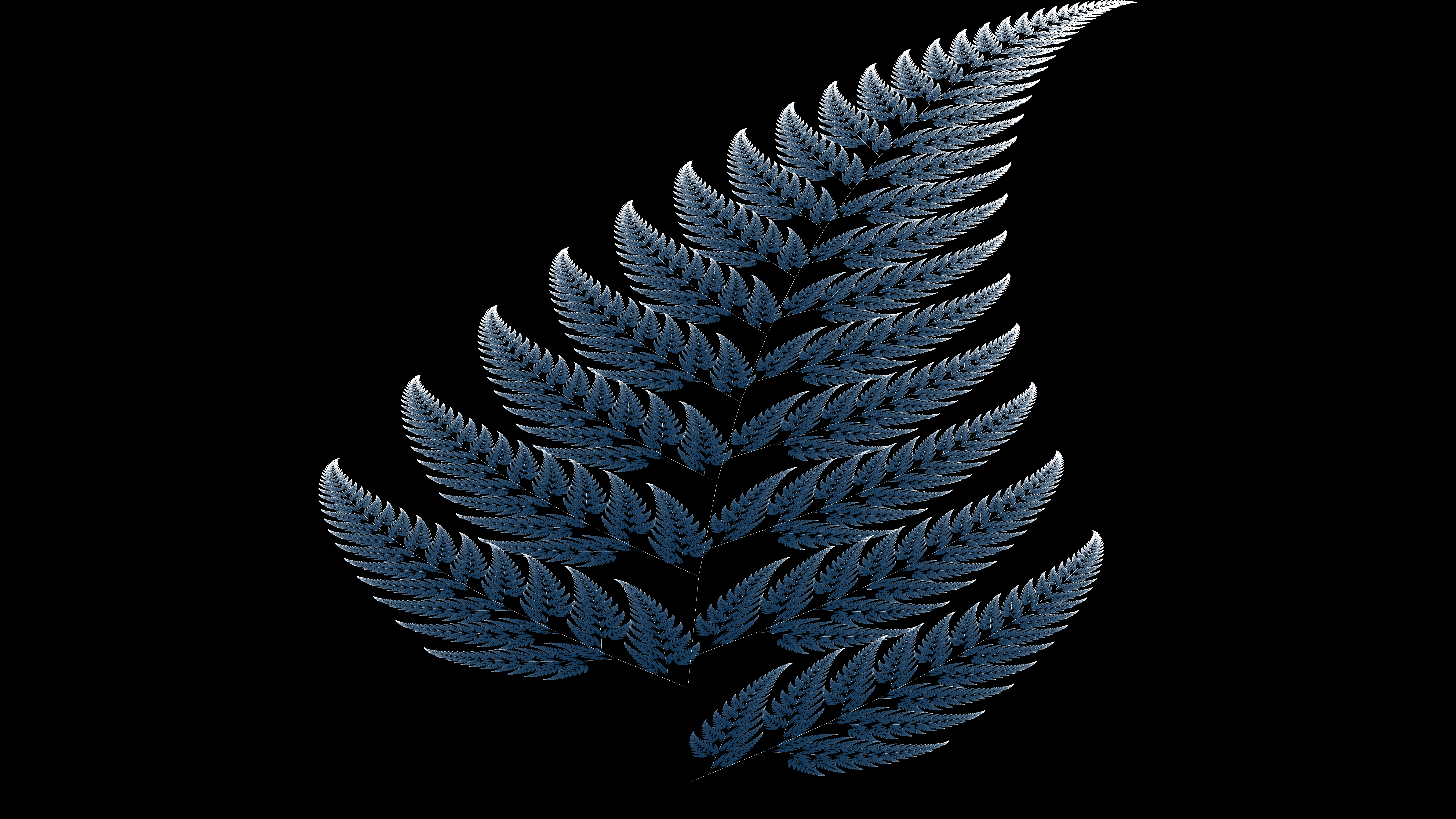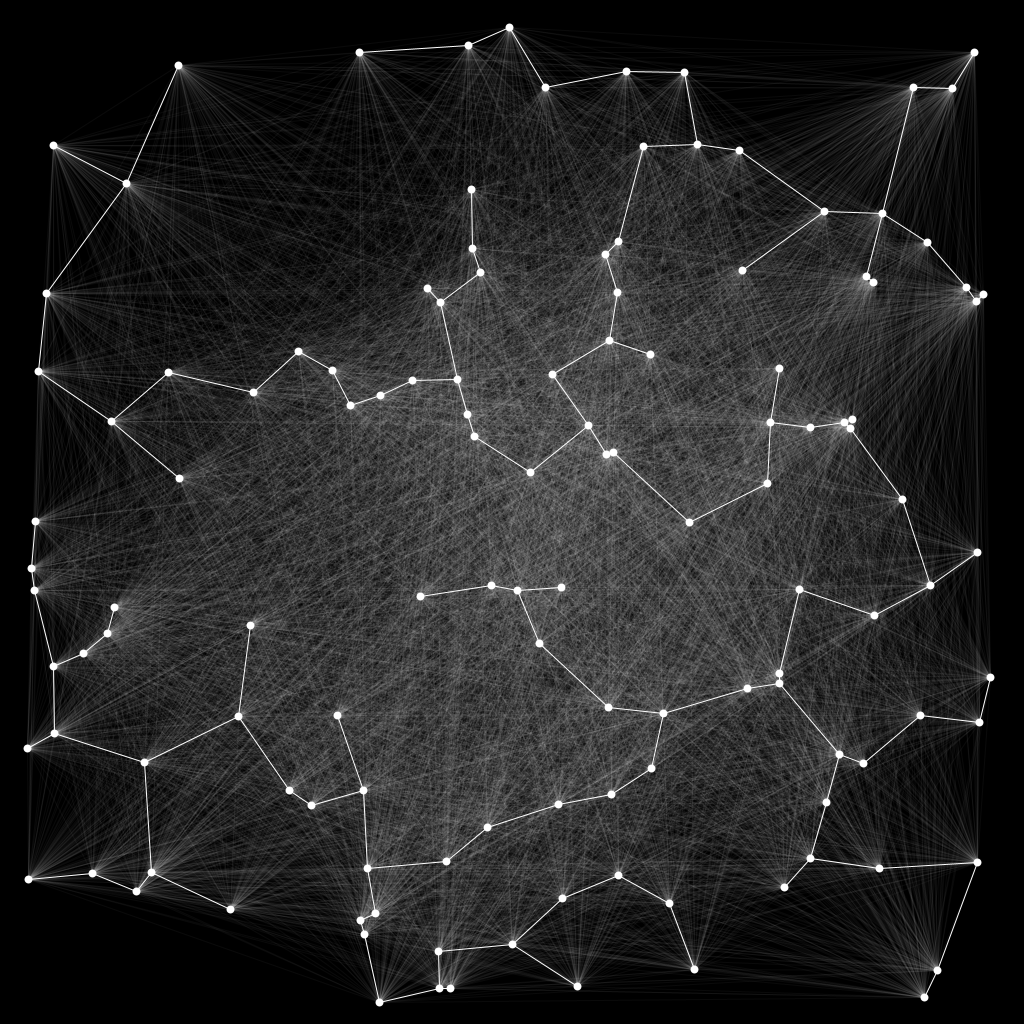
This program works by creating a grid of evenly-spaced points. Each points has a corresponding object that rotates about that point and is assigned characteristics such as rotation radius, shape, and color that corresponds to the same x and y position of a source image. The phase of each object's rotation to the brightness value of the source image's corresponding pixel. This project taught me a lot about JavaScript and made for some fun animations.
Read More
The Barnsley Fern is a fractal pattern named after British mathematician Michael Barnsley. It is generated by an iterative process that involves repeatedly applying a set of geometric transformations to a simple initial shape. The resulting fern-like pattern displays self-similarity at different scales, and has applications in computer graphics, image compression, and chaos theory.
Read More
- Distance formula 1 execution time: 2224ms
- Distance formula 2 execution time: 4ms
- Distance formula 3 execution time: 3ms
Read More
Launch this sketch is a new window (recommended)
Launch p5.js web editor
The Ulam Spiral or prime spiral is a graphical depiction of the set of prime numbers, devised by mathematician Stanislaw Ulam in 1963 and popularized in Martin Gardner's Mathematical Games column in Scientific American a short time later. …
Read More TurboReader is my solution to the poor input performance of Scanner. All I need from a Reader in most programming contest problems is the ability to read ints and Double, and to read them quickly. That is all this class does, and it also tokenizes those values so that I never have to address empty lines in the text …
TurboReader is my solution to the poor input performance of Scanner. All I need from a Reader in most programming contest problems is the ability to read ints and Double, and to read them quickly. That is all this class does, and it also tokenizes those values so that I never have to address empty lines in the text …
Read More
Kruskal's algorithm is a greedy algorithm used to find the minimum spanning tree of a connected, weighted graph. The algorithm works by sorting the edges of the graph by weight, and then adding the edges to the minimum spanning tree one by one, making sure to avoid creating cycles. Kruskal's algorithm has a time complexity of O(E log E) where E is the number of edges in the graph, and is widely used in network design and optimization problems.
Read More
I created my own Collatz Conjecture visualization, experimenting with a unit circle design that resulted in 360 distinct "branches". While it may not offer groundbreaking insights, the process was enjoyable and yielded interesting results, particularly for the number 327.
Read More I'm working on a few programs that I will be using using to visualize algorithms on procedurally generated terrain. This particular program visualizes a minimum spanning tree using Prim's Algorithm on random walkers. The terrain is 128x128 tiles, each containing 4 vertices on the negative y-axis that I applied a Perlin …
I'm working on a few programs that I will be using using to visualize algorithms on procedurally generated terrain. This particular program visualizes a minimum spanning tree using Prim's Algorithm on random walkers. The terrain is 128x128 tiles, each containing 4 vertices on the negative y-axis that I applied a Perlin …
Read More So I participated in the AT&T Hackathon this year. I approached it as R&D for developing 3D games that run on Android. I don't have much to say about it except that I learned an awful lot about the limitations of Android, which in turn taught me a lot about optimization techniques, DPI-scaling and the matrix …
So I participated in the AT&T Hackathon this year. I approached it as R&D for developing 3D games that run on Android. I don't have much to say about it except that I learned an awful lot about the limitations of Android, which in turn taught me a lot about optimization techniques, DPI-scaling and the matrix …
Read More
This is a (perhaps overkill) 3D WEBGL visualization of Merge Sort using the WEBGL rendering mode.
Read More
This sketch is a browser-based image filtering utility inspired by 10PRINT. The UI allows users to produce faithful looking interpretations of 10PRINT, 10PRINT patterns that look hand-drawn, and users can even create an explosive shit-mess of scribbles, if they so wish.
Launch this sketch is a new window …
Read More
This is a (perhaps overkill) 3D WEBGL visualization of Insertion Sort using the WEBGL rendering mode.
Read More
Expanding on last night's work with Open Simplex Noise. I figured the next logical step was to make a Minecraftian terrain generator, so here it is. If I ever felt compelled to build a game from the ground up, this would probably be my starting point.
Read More
So, I was on the hunt for a simpler way to make cool looped animations and stumbled upon this thing called 4D Simplex Noise. I found a super helpful tutorial on necessarydisorder's WordPress page called "Drawing from noise, and then making animated loopy GIFs from there". It was really informative, got me inspired, and had a spot-on title.
Read More
Simple animation of tiles flipping. They can flip randomly or they can be flipped by applying Perlin Noise.
Read More
